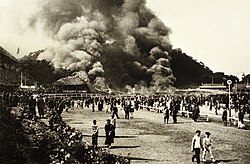 | |
| Date | 26 February 1918 (1918-02-26) |
|---|---|
| Time | 15:00 (UTC+8) |
| Location | British Hong Kong |
| Coordinates | 22°16′22″N 114°10′56″E / 22.27278°N 114.18222°E / 22.27278; 114.18222 |
| Casualties | |
| 614 dead | |

The Happy Valley Racecourse fire (Chinese: 跑馬地馬場大火) took place on 26 February 1918 in the Happy Valley Racecourse located at Happy Valley, British Hong Kong. The catastrophe caused the loss of 614 lives. In mainland Chinese sources, this is often included in the top ten fires in 20th-century China.
Background
The racecourse was first built in 1845 to provide horse racing for the British people in Hong Kong. The area was previously swampland, but the only flat ground suitable for horse racing on Hong Kong Island. To make way for the racecourse, the Hong Kong government prohibited rice growing by villages in the surrounding area. The first race ran in December 1846. Over the years, horse racing became more and more popular among Chinese residents.
Fire
The annual "Derby Day" race was held every February, and a temporary grandstand was built to accommodate the extra spectators. The fire was caused by the collapse of the temporary grandstand on the second day of the event. The collapse knocked over food stalls which set bamboo matting ablaze. The district's fire department was so stretched that the marine police were called up to help fight the fire. By the next day, as many as 576 confirmed deaths were reported by the Hongkong Telegraph.
Aftermath
Most of the dead bodies became unrecognisable and assumed to be "Chinese". 614 bodies were officially recovered. In mainland Chinese sources, this is often included in the top ten fires in 20th century China.
The nearby Tung Wah Hospital was one of the first to offer assistance and after the fire arranged for labourers to collect the dead. They were buried in the nearby So Kon Po area (now the site of Hong Kong Stadium). A Chinese-styled memorial site known as Race Course Fire Memorial was built in the Chinese cemetery (now behind the east stand of the stadium) in 1922 in So Kon Po. It was declared a monument in 2015.
See also
Bibliography
Notes
- ^ Bard 2002, p. 367
- ^ "走进"119" 关注身边事(119宣传专栏)". 南京邮电大学保卫处. 2009-09-16. Archived from the original on 2022-01-01. Retrieved 2022-01-09.
- Ward 1991, p. 85
- Antiquities and Monuments Office 2018
- Government of Hong Kong 2015
References
- Antiquities and Monuments Office (2018). "Declared Monuments in Hong Kong - Hong Kong Island". Antiquities and Monuments Office. Archived from the original on October 31, 2019. Retrieved February 27, 2018.
- Bard, Solomon (2002). Voices from the Past: Hong Kong, 1842-1918. Hong Kong University Press. ISBN 9789622095748. - Total pages: 383
- Government of Hong Kong (October 23, 2015). "Three historic buildings declared monuments". Government of Hong Kong. Retrieved February 27, 2018.
- Ward, Iain (1991). Sui Geng: The Hong Kong Marine Police 1841-1950. Hong Kong University Press. ISBN 9789622092860. - Total pages: 236
| [REDACTED] | This fire-related article is a stub. You can help Misplaced Pages by expanding it. |
- Horse racing venues in Hong Kong
- Tourist attractions in Hong Kong
- Fires in Hong Kong
- 1918 in Hong Kong
- 1910s fires in Asia
- 1918 disasters in Asia
- 1918 fires
- Happy Valley, Hong Kong
- February 1918
- Stadium disasters
- Man-made disasters in Hong Kong
- Accidental deaths in Hong Kong
- Fire disasters involving barricaded escape routes
- Sports venue fires
- Fire stubs